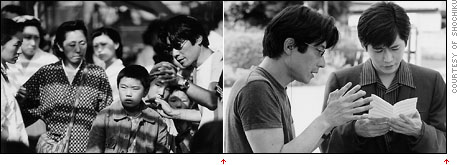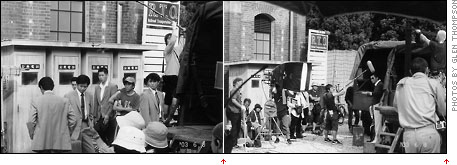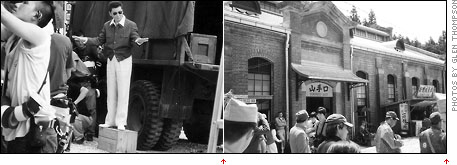Out of This World – Set Report
- published
- 20 September 2003

"Jazz", a word that conjures up countless images. In World War II era Japan, jazz was deemed the music of the enemy - the music of America. For the Japanese, it remained a secret pleasure until the war ended and the occupation forces arrived. No longer verboten, it became part of the free marketplace. Young musicians had a chance to rise above post-war destitution and play without fear of reprisals, often in US military clubs.
This is the backdrop for writer-director Junji Sakamoto's latest film Kono Yo no Soto e: Club Shinchugun (English title Out of This World, a nod to the Harold Arlen composition that modern jazz master John Coltrane famously transformed). There have been a good number of Japanese films over the years that have prominently featured jazz, such as the old Frankie Sakai films of the 1950s, Kihachi Okamoto's Dixieland Daimyo (Jazu Daimyo, 1986), and Makoto Wada's 2001 film Mayonaka Made (a.k.a. Round About Midnight). However, jazz aside, Out of This World is unique for many reasons. I had the opportunity to take part in the filming for six days as an extra.

In pre-production, casting was an especially important element of this film, with its mix of occupation-era characters. Scottish actor-director Peter Mullan (Trainspotting, My Name is Joe) and up-and-coming American thesp Shea Whigham (All the Real Girls, Tigerland) are the two foreign leads. Mullan plays Jim, the fatherly owner of the "Enlisted Men's Club", where the troops of the day would unwind and a good portion of the film's story takes place. While occupation force soldiers were chosen specifically for their lack of bias against the Japanese, Whigham's character Russell is a bitter jazz prodigy who lost a brother in battle. The Japanese cast is lead by heartthrob of the moment Joe Odagiri (Bright Future, Azumi), who plays Shozo, an amateur drummer trying to escape the atomic devastation he left behind in Nagasaki. Masato Hagiwara (Cure, Chaos, Go) is the leader of the band, and at war musically and culturally with Whigham's sax genius. Claude Maki (Brother, A Scene at the Sea) plays Kelly, a nisei (American-born Japanese) who provides club security and speaks in English. Modern-day yakuza film icon Sho Aikawa (Dead or Alive, Blood Brothers) plays black marketeer Jerry Nakata, who pretends to be a nisei by speaking heavily-accented Japanese. Aki Maeda (Battle Royale), Jun Murakami, and other familiar faces round out the impressive cast.
Out of This World's interesting dynamic onscreen was mirrored behind the scenes. Sakamoto's interpreter (and the screenplay's translator) was well-known film subtitler and producer Linda Hoaglund, whose collaboration with Sakamoto now spans five films. David d'Heilly, longtime Tokyo resident and Nobuhiro Suwa collaborator, through his company 2dk, took the reigns of assembling and assistant directing the foreign extras that populate the film. Says d'Heilly: "The different acting styles, the emotionally demonstrative acting of the foreigners vs. the technical, self-aware Japanese approach paralleled the 'hot and cold' of the two cultures' situations. I've often thought that Japanese acting styles were difficult for western audiences to empathize with. I think that here we opened that issue up and presented it in a very natural way, made cinematic via the music. The GIs provided the backgrounds of ebullience and racism that helped the Japanese see where jazz gets its soul."
While obviously playing Americans, the GI extras' actual backgrounds were North American, European and African. Almost everyone had a chance to actually do something onscreen, with several people scoring lines of dialogue. Watching the pros was interesting, too. Whigham's intense method-school acting clashed in a positive way with Mullan's ability to switch on and off at a moment's notice.

A good portion of the shooting took place at the legendary but timeworn Nikkatsu studios in Tokyo's Chofu City. There, in Studio 8, a replica of a 1940s American military club was constructed. From the stage, complete with wings and dressing rooms, to the stocked bar, manager's office, Wurlitzer jukebox, right down to the harsh unfiltered Lucky cigarettes the extras had to smoke, the attention to detail was impressive. The combination of practical lights and movie lights suspended from the roof allowed the actors and camera to move freely on the floor, including a massive crane used to shoot the film's final, somber scene. The budget was definitely high for a Japanese movie, and Sakamoto's highest yet, but while this afforded more production value than many domestic productions, the most still had to be made of finite resources and a tight schedule.
Being on a movie set is always a lot of "hurry up and wait", especially for extras, but there was always plenty to watch. In one scene, Hagiwara's band play country and western music dressed in cowboy duds alongside two sexy dancing girls in sailor's outfits. This doesn't go down well with the bored African-American GIs, who are much happier when the band switch to jazz (to the chagrin of the white patrons). The racial tension sets off a battle-royale. After some brief training by a stunt coordinator on loan from Takeshi Kitano's neighbouring Zatoichi set, the action began. The "over-enthusiasm" of the extras caught the director and producers off guard, but it was all laughs once the cameras stopped rolling. The film's producer (frequent Sakamoto executive producer Yukiko Shii) was "scared" of how realistic the fisticuffs looked. Other days on the club set included Jim's big birthday bash, in which a beautiful torch singer serenades him with Les Brown's "Sentimental Journey" (It wasn't until the following day it clicked that the sultry songbird was Aki Maeda, matured since her junior-high school turn in Battle Royale.) The party turns sad when Hagiwara's character exacts revenge for an earlier humiliation by playing "Danny Boy", with everyone present knowing Jim's son Danny had been killed in a car accident the year before. Said song is reprised in the final scene, to powerful effect.

Location work was a major element of the filming as well. In lush Matsuida, Gunma prefecture, the talented craftspeople converted an old power station into a period replica of a train station on Tokyo's famed Yamanote line, complete with black market. As the station is a tourist attraction in the area, there were plenty of locals who had heard about the filming. Priceless were the expressions on the faces of senior citizens as the GI extras strolled the kilometer or so to the set - you could see the memories flooding back in their faces as they greeted us with a friendly konnichiwa (and who knows what other words they kept inside). The facade of the station bustled with GIs, poverty-stricken kids, a magician, and various street vendors. The scenes here involved Sho Aikawa as a black marketeer looking for musicians and dancers to load onto trucks and send to the army clubs. Aikawa sat, smoked and joked with us and the crew. Young female fans tried all day to get glimpses of Joe Odagiri, while the hakujin (white) extras were told to stay out of the sun to keep our faces from turning red.
In comparison to all the sets I've been on in North America, the feeling here is much different. It's a job with very little time or need for people to put on airs. In contrast to even low-budget American films, some of the actors, the cinematographer, and even Sakamoto himself would catch the same trains and buses to the studios and locations as the extras and PAs. Sakamoto is only in his 40s, but is a seasoned veteran on the set, doing very few takes and working as quickly as the crew's set-up time would allow him to. Ultimately, it seemed as if he got what he wanted from the staff, actors, and motley band of extras alike.
The film is now in post-production, and rough assemblies have yielded positive notices. Out of This World has a good chance to screen at international film festivals, and will go into wide domestic release in February, 2004. Ideally, the strength of the film as well as the young Japanese stars and Mullan's name will give it a theatrical shot at success at home, Europe and beyond.
Interview with writer-director Junji Sakamoto
By Jason Gray and Jasper Sharp
Where did the idea behind this film come from, and why did you decide to tell this particular story?
It was at the suggestion of producer Yukiko Shii. I thought it was a somewhat reckless project, but I took it on because I thought the war should be touched on during these currently smoldering times. I also was anxious yet interested in depicting an era that existed before I was born. Since Iw anted to make an entertaining movie, I thought the best way to convey this post-war period was through music.
What resonance does jazz have in Japan, and to you personally?
I'm not that strictly into jazz, but I used to listen to people like Coltrane while sleeping.
Few films deal with the US Occupation of Japan. Why did you choose this era?
When touching on the war, most films' scenes are often structured around the battleground.
What was the most difficult aspect of realizing your vision on this project?
Creating a "human" reality for the entire cast, right down to the background extras.
How did the casting of Peter Mullan come about?
It was decided after I went to Glasgow to meet Peter, discussing it with him directly. Prior to my visit he had read the screenplay.
How was it to work with young stars such as Aki Maeda and Joe Odagiri on this film?
Aki and Joe are the type of actors that will grow and mature after this project. I hope they become great screen actors.
What historical fact surprised you most during the research for the film?
The fact that the occupying forces were mainly soldiers that fought on the front lines in Europe, or else soldiers that had no war experience at all. America sent soldiers that had no hatred or bias against the Japanese.
What was it like working with so many foreigners? Is this the first time you have worked with so many non-Japanese?
Considering some of the performing required wasn't that easy to do, I was amazed at the lack of hesitation - that's a difference in culture. Everyone did a good job!
What feeling do you hope audiences come away with? And did you have an international audience in mind while shooting?
Even being aware of foreign audiences, I didn't feel the need to do anything differently than I normally do when I direct films. It would be good if, through this film, audiences come away thinking about "hatred" and "reconciliation".
(Special thanks to Hiromi Aihara)